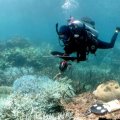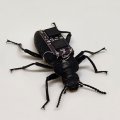Small marine life give big picture of Moreton Bay
Intertidal sand pools on Moreton Bay are both a temporary home for juvenile fish and prawns and an indicator of the health of a waterway which supports a major fishing industry, according to a University of Queensland researcher.
Jeff Kwik, a PhD researcher in the University's School of Marine Sciences, has spent the past two years studying the life in sand pools made at high tide by feeding stingrays.
"They could, for example, be damaged by outflows from stormwater drainage," Mr Kwik said. "Where drainage pipes are located could effect potentially important fish and prawn nursery areas."
The stingrays can leave as many as 200 pools in an area of 10 square metres, ranging from 20 centimetres to 1.5 metres in radius, and between six and nine centimetres deep.
No studies have previously been conducted on the importance of the pools as a nursery habitat. They usually last about one and half weeks before being washed away.
Mr Kwik has conducted his study at four sites - One Mile Beach and Adams Beach on North Stradbroke Island, Hayes Inlet at Redcliffe and at Fishermens Island at the mouth of the Brisbane River.
By far the most prolific among the 19 species of fish and three species of prawns he has identified in the pools are the sand whiting and the eastern king prawn.
While there are more of the creatures at the North Stradbroke and Redcliffe sites, the diversity is the same as at the busy Fishermens Island dock area, Mr Kwik has found.
He is hoping to discover if they live in the pools because it is easy to obtain their diet of tiny crustaceans, or whether it is to avoid predators such as flathead waiting in the shallows.
"We don't know if they feed at the high tide mark, at the low tide mark, or in the pools, so they don't have to move to the low tide mark and expose themselves to danger from predators," Mr Kwik said.
Mr Kwik said the fish and prawns appeared to be remarkably tolerant to heat and varying salinity levels, as the water in the pools can reach 35 degrees Celsius.
The fish larvae, born between November and March, move into the pools when they are only about 10 millimetres long, while the prawns breed in winter.
"In pools with an average radius of 70 centimetres I have been finding on average eight prawns and five whiting, with an average size of 12 millimetres," he said.
"The largest whiting I have found was 21 millimetres long, and I have discovered prawns up to six centimetres at Redcliffe."
The research hasn't been without its share of pain for the Singapore-born Mr Kwik, who has been studying in Australia for four years, two at the University.
He has received one particularly nasty sting on the foot after stepping on a well-buried blue spotted stingray, even though he was wearing protective footwear, and at least two more on his arm.
The thesis has fired Mr Kwik's interest in Moreton Bay, and future plans include a closer look at the development of the fish in the pools, and a further study of the habits of the stingray.
For more information, contact Mr Kwik (07) 3365-1035 (day) or 3407-3316 (evenings).
.jpg)


